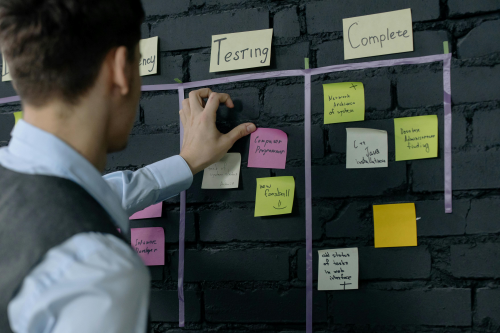Agile Journal Blogs
Team Kanban Flow
By Ishy Bansal

Mastering the Art of Kanban Flow: Lessons from My Agile Journey
In my career, I’ve had the privilege of working with many teams across different industries. One of the most transformative frameworks I’ve encountered is Kanban. On the surface, Kanban might seem like a simple visual tool for tracking work. But as I’ve learned through experience, it’s much more than that—it’s a mindset and a philosophy that can revolutionise how teams work.
Discovering Flow
I first encountered Kanban when working with a team struggling to keep up with an overwhelming workload. Their board was a chaotic mass of sticky notes, with tasks in every stage of completion. Work was started but rarely finished, and team morale was low. After observing their process, it became clear they were trying to do too much at once, leading to inefficiencies and frustration.
The solution? We implemented Work-In-Progress (WIP) limits. By restricting the amount of work allowed in each stage of the process, we forced the team to focus on completing tasks before starting new ones. It wasn’t easy at first—old habits die hard—but over time, the team began to see the benefits. They were delivering more consistently, and the sense of accomplishment from finishing work boosted morale.
Visualising the Big Picture
Another breakthrough came when we restructured the Kanban board to better reflect the team’s workflow. Instead of generic columns like “To Do” and “Done,” we mapped out the specific stages of work, such as “Design,” “Development,” “Testing,” and “Release.” This level of detail gave the team greater clarity and highlighted bottlenecks in the process. For example, we discovered that tasks were piling up in the testing column because the team hadn’t allocated enough resources to that stage. By addressing this, we significantly improved the overall flow.
Empowering Teams Through Transparency
One of the most rewarding aspects of using Kanban is how it empowers teams to take ownership of their work. By making the workflow visible, everyone can see what needs to be done and where the challenges lie. This transparency fosters collaboration and accountability. I remember one instance where a team member noticed a task stuck in the “Review” column for several days. Instead of waiting for someone else to address it, they proactively offered to help, sparking a new culture of shared responsibility.
Continuous Improvement
Kanban is inherently about evolution. The mantra “start where you are” resonates deeply with me. When I introduce Kanban to teams, I emphasise that it’s not about overhauling their entire process overnight. Instead, it’s about making incremental changes, observing the impact, and adjusting accordingly.
One team I worked with adopted regular retrospectives focused on their Kanban flow. They used metrics like lead time and cycle time to identify areas for improvement. Over several months, they made small but meaningful changes, such as adjusting WIP limits and redefining their definition of “done.” The result was a more efficient process and a happier, more cohesive team.
The Human Element
While the mechanics of Kanban are important, it’s the human element that truly makes it work. Effective Kanban requires trust, communication, and a willingness to adapt. I’ve seen teams struggle because they viewed Kanban as just another tool, rather than embracing it as a way of thinking. Conversely, I’ve witnessed teams thrive when they fully committed to the principles of Kanban, such as respecting WIP limits and prioritising finishing over starting.
Final Thoughts
Kanban has taught me that agility isn’t just about speed; it’s about flow. It’s about creating an environment where work moves smoothly from start to finish, and where teams feel empowered to deliver their best. Whether you’re new to Kanban or looking to refine your approach, I encourage you to focus on the principles of flow, transparency, and continuous improvement. With these foundations in place, the possibilities are endless.